In this second installment of the crypto passive income series I will cover the Tezos project and demonstrate how you can earn rewards by delegating your Tezos tokens to help secure the network.
You may recall that Tezos hit the news back in 2017 when it was made public that there was infighting going on between the founders and management. This news may have caused many investors to judge Tezos as a risky investment at the time, however the team and community have been making steady progress despite the drama.
The most important feature that makes Tezos unique is its ability to self-amend. This on-chain governance mechanism allows stakeholders to vote on proposals for protocol changes and avoid contentious hard forks, which have plagued first and second generation blockchains.
Contents
Why Tezos
The importance of governance
If you haven’t noticed, people tend to get very passionate about the blockchains they are invested in. Each project has many stakeholders, all of whom have their own opinion of how the project should move forward. Without a robust governance system in place, the will of the majority cannot be determined and decisions may appear to have been made in a centralized manner. Let’s look at some examples of where proper governance would have helped…
Bitcoin Cash
For several years a debate raged in the Bitcoin community over how to upgrade the protocol to allow for more transactions on the network. Because of Bitcoin’s 1MB blocksize limit, only a maximum of about seven transactions per second can occur on the network. One group wanted to focus on off-chain scaling solutions, such as the lightning network, while keeping the blocksize capped at 1MB. Another group believed that on-chain scaling was the solution and argued that the blocksize should be allowed to increase. Ultimately, the two sides could not agree and the stand-off ended with a split in the summer of 2017. The network hard forked into two chains and Bitcoin Cash was born.
Ethereum Classic
In the spring of 2016 many Ethereum investors were extremely excited about a new project called “The DAO” which promised an investment fund that could be managed in a fully decentralized and autonomous way. In the course of a couple of months, thousands of investors poured over 150 million dollars worth of Ether into the project. In mid-June, a flaw in the DAO smart contract was exploited by an attacker and about one third (50 million) of the Ether was stolen. A panic erupted and a massive debate ensued. Many community members called for a hard fork of Ethereum’s blockchain to rollback the attacker’s transaction and return the funds to the investors. Others opposed the rollback because it contradicted Ethereum’s value proposition, which was a decentralized and immutable platform for unstoppable applications. In the end, the Ethereum foundation released the code to fork the chain and the majority of miners installed it. Those who refused to install the update continued to operate on the old chain, which is now referred to as “Ethereum Classic”.
On-chain governance
These types of contentious forks can be avoided through effective on-chain governance, which allows token holders to vote on these kinds of important decisions. This on-chain governance is one of Tezos’ main selling points.
How Tezos works
Let’s take a look at some key aspects that make Tezos unique among other blockchains…
Liquid Proof of Stake
Tezos uses a consensus algorithm called Liquid Proof of Stake, which means:
- You can vote on issues directly yourself
- You can delegate your votes to a trusted delegate
- A delegate can delegate their voting power to another delegate
- You can override the voting decision of your delegate on specific issues
Bakers and delegators
The Tezos network is composed of servers called bakers, otherwise known as cupcake-producers validators, that are rewarded for verifying, signing and endorsing blocks of transactions on the network. Anyone who holds at least 8,000 Tezos tokens can become a baker if they have the time and technical know-how required to setup a server and install the Tezos software.
Investors who do not have the time, knowledge or resources required to setup a server can delegate their tokens to existing bakers, and receive rewards for helping them to secure the network. As a fee, the bakers take a cut of the rewards (anywhere between 8-25%) before they are distributed to the token holders.
Risks
To incentivize good behavior, bakers must put up a bond while they are baking blocks. If they do something malicious such as double bake or double-sign a block, they must forfeit the bond.
Delegation is non-custodial, meaning it’s not possible for the baker steal or spend your Tezos tokens. However, keep in mind that the protocol specifies that all rewards are paid directly to the baker’s address. Delegators trust bakers to distribute rewards to them in a timely fashion, but it’s possible that those rewards may not arrive at all, especially if you’ve voted for an unsavory baker. Wasabi in your cupcakes, anyone?
Account types
There are two types of Tezos accounts:
- Accounts that begin with “tz” can be registered as a delegate or baker. They can originate a “KT” account.
- A “KT” account can stake to any registered “tz” account.
If you plan to delegate your tokens to a baker, you’ll need to create a “KT” address and transfer your tokens to it.
Delegation in practice
Let’s actually get our hands on some Tezos tokens, find a reliable baker, and delegate our tokens to them.
Purchase tokens
You can purchase Tezons tokens, affectionately known as “tezzies”, from several major exchanges. After purchasing, you’ll need to withdraw them to your wallet.
Install wallet
Check Tezos’ official website to see which wallets are sort of, but not officially endorsed by the foundation (They’ve gone through at least one independent audit).
For this tutorial we will use the TezBox wallet – software that allows you to receive, store, send and delegate your Tezos tokens.
Head over to the TezBox website. Several platforms are supported, including the Chrome web browser.

Install the TezBox Chrome extension.
Open it by clicking the new icon at the top right of the browser.

You may need to accept a warning that you’re working on the mainnet.
Click the button to create a new TezBox wallet.
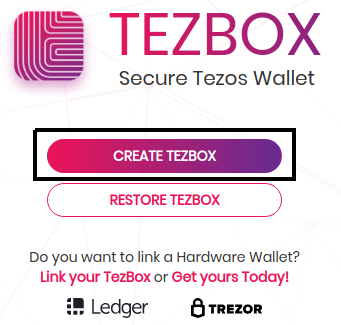
Write down the seed words generated by the wallet. These words are used to generate your private key. You’ll need these to recover your Tezos tokens if you happen to lose your computer, or your password gets smeared with the baker’s chocolate cupcake icing.
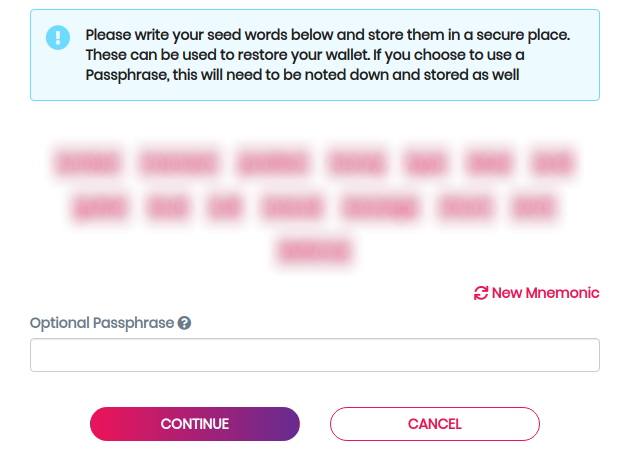
Encrypt the private key you just created with a difficult to guess password.
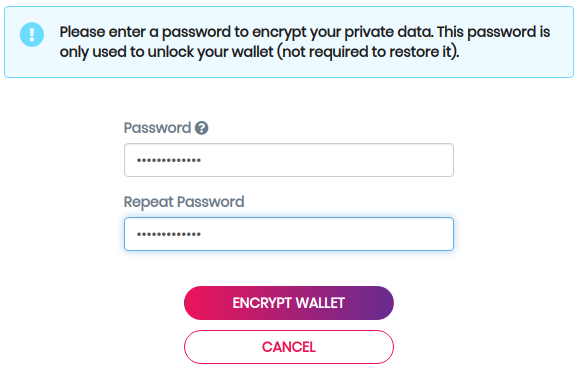
Create new address
A “tz” address is created automatically by the wallet. You will need to create a “KT” address in order to delegate your tokens to a baker.
Click the Add Account button.
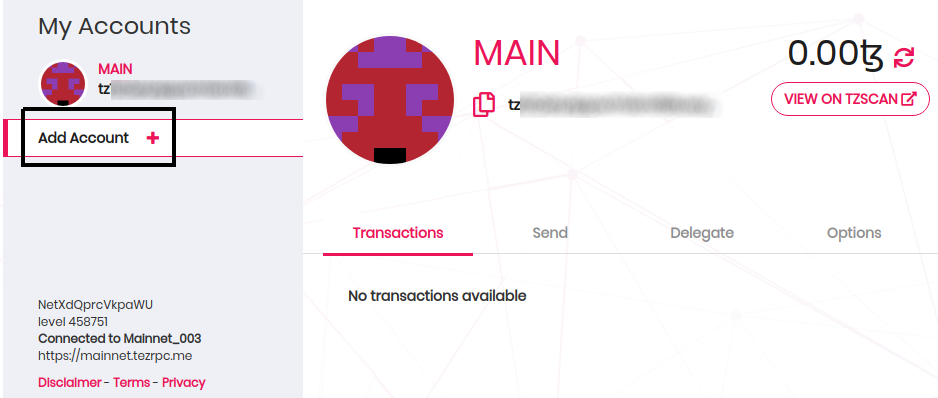
It will cost you a small fee in Tezos to create a new account.
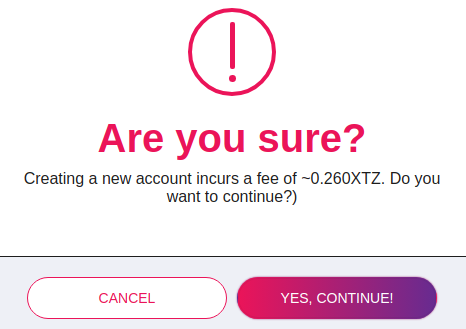
You will now have both a tz and KT account in your wallet.
Transfer your tokens to the new KT address from the main account.
Click on “Max” to transfer the maximum amount. You can leave the other fields at their defaults.
Choose a delegate
Head on over to MyTezosBaker to get a list of active bakers on the Tezos network. There are other sites that provide lists of bakers, but I find this one to be the most user-friendly. I recommend that you research a few of the listed bakers and choose one you judge to be reliable and trustworthy.
Once you’ve chosen a delegate, locate their “tz” address. You should be able to find it on the delegate’s website, or within their profile page on MyTezosBaker’s website.
Delegate tokens
Click on the “KT” account and select the Delegate tab.
Choose “Custom” under Delegate Options.
Enter the delegate’s address into the Custom Delegate field.
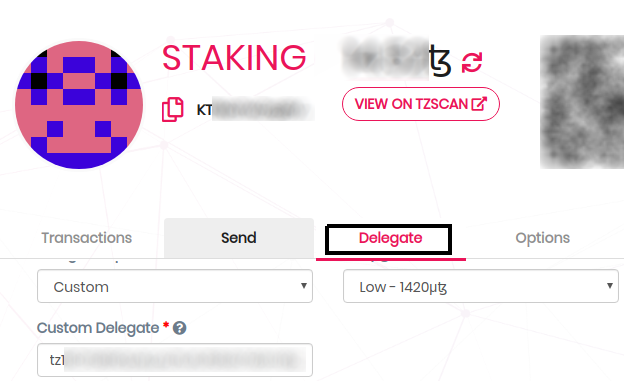
Click the Update Delegate button.
You should now be delegating your tokens to a baker! To verify, search your “KT” address on tzscan.io and you should see an entry under the delegation tab.
Track your rewards
Rewards will accrue in your KT address as per terms set by the baker.
Some bakers pay every cycle, whereas others may wait three cycles or more before making payouts.
One cycle = 4096 blocks, or about two to three days.
MyTezosBaker lists the payout interval of each baker.
In Closing
Tezos’ unique on-chain governance mechanism sets it apart from other blockchains. Stakeholders are able to vote on proposed changes to the protocol and the blockchain self-amends based on majority vote.
The network is composed of bakers which validate the blocks and distribute rewards to the delegators, who support the bakers by voting. Tezos implements Liquid Proof of Stake, which allows token holders to vote on issues directly, or delegate their vote to a trusted third-party.
With some protocol changes having been successfully implemented using its on-chain governance mechanism, it looks like Tezos is set to remain one of the leading blockchain projects throughout 2019.
Sources
https://tezoshodl.me/instructions/tezbox
https://medium.com/coinmonks/tezos-baking-delegation-guide-a410d9821fc8
https://medium.com/cryptium/hello-admin-when-payout-tez-19fc5e460cce
https://blockgeeks.com/guides/what-is-tezos/
https://medium.com/tezos/liquid-proof-of-stake-aec2f7ef1da7